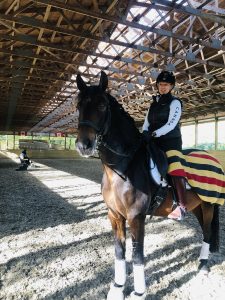 My equestrian leadership roles as coach, clinician, coach developer, committee chairperson and conference presenter have allowed me the opportunity to travel internationally and learn from some of the most renowned coaches, athletes and technical leaders in our sport. As I work through the HPCTL program, I am continually inspired and humbled by the wealth of knowledge imparted to me by the professors and fellow cohort, and as my passion has always been to educate and inspire others, I appreciate the course information and tools gained to recognize where I can improve and elevate my coaching and leadership practices.
My equestrian leadership roles as coach, clinician, coach developer, committee chairperson and conference presenter have allowed me the opportunity to travel internationally and learn from some of the most renowned coaches, athletes and technical leaders in our sport. As I work through the HPCTL program, I am continually inspired and humbled by the wealth of knowledge imparted to me by the professors and fellow cohort, and as my passion has always been to educate and inspire others, I appreciate the course information and tools gained to recognize where I can improve and elevate my coaching and leadership practices.
Studying Kouzes and Posner 2017, The Leadership Challenge, completing the self-assessment and LPI workbook, and reviewing the SLPI feedback provided valuable insight to my current leadership practices, and development of my Personal Improvement Plan. The clear guidelines resulted in a formal, educated inventory of my daily procedures, interactions and approaches to self-reflection. This process inspired a greater self-awareness and determination to strive towards excellence in leadership. Guided by my core values of safety, teamwork, accountability, integrity, and resilience (STAIR), I will focus on the key practices of modelling, inspiring and enabling by setting a positive example of expected behaviour, taking action and encouraging others to share a vision for the future, creating a productive, cohesive team.
In planning ahead for future assignments, I will consider challenging the process in equestrian sport by exploring the need for renovation of our provincial competition pathways, talent identification, and coach education. The implementation of criteria, and creation of pathways for riders and coaches are important links for promoting participation in competition, leading to the development of potential high performance athletes. Encouraging sport for life, and the well-being of participants starts at the grass roots. My goals are to share a vision of positive change for the future, engage coaches through ongoing education and support them in preparing their riders to follow a competition pathway.
The first small step to implement change is possible within my own dressage program, Fit To Ride (F2R). Developed in the 1990’s, my original idea was to bridge the gap between riders with and without disabilities and integrate athletes with disabilities into the mainstream horse industry, providing them with opportunities to compete at recognized competitions. Equity and inclusion were primary considerations and as the program grew it encompassed many athlete profiles, from para equestrian riders training for high performance on the world stage, to young riders vying for spots to represent Canada at the North American Young Rider and Junior Championships, to adult amateurs competing locally and provincially and also coach candidates studying for certification.
Recently, working on the culture of excellence project, investigating current sport and leadership issues, I recognize the need for a culture of change in our industry to promote longevity and well-being in our sport, as well as the need to redirect the focus of my program back to young riders and coaches. As a coach developer and certification evaluator it is evident that new coaches require more education and experience pertaining to fundamental riding, equitation and horsemanship skills in order to properly prepare riders and provide them with a solid foundation of skills. This observation was reinforced during my research and interviews with colleagues, officials, coaches and other equestrian industry stakeholders. It solidified that providing education in the noted areas is the first stepping stone towards the development of well-rounded, capable equestrians who will support our industry in the future.
I look forward to future mentor meetings to discuss ideas and get feedback on ways I can improve and adjust my program and contribute to improving sport culture in the equestrian industry.
